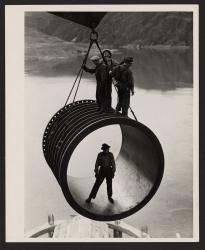Through August: Exploring Hidden Cost of Grand Coulee Dam

During the 1930s, proponents of the Grand Coulee Dam were quick to emphasize the progress the dam would bring to the country. Indeed, Grand Coulee provided thousands of jobs during the Great Depression, aided the American World War II effort and irrigated vast areas of central and western Washington. The dam remains the largest energy producer in the United States.
But a Washington State University exhibit that will run through Sept. 1 shows the dam’s hidden costs for those who lived near the construction site: the notorious escapades of dam workers after hours in the town of Grand Coulee; the flooding of the Native American town of Inchelium; and the failed first farming experiments of the Columbia Basin Project.
“Concrete Dreams: Living with the Grand Coulee Dam” opened April 21 in WSU Manuscripts, Archives and Special Collections. Students of the class, “Interpreting History through Material Culture,” taught by history associate professor Robert McCoy, worked with MASC’s Trevor Bond and WSU Libraries’ Amy Grey to create the study of Grand Coulee Dam’s lesser-known impacts.
“While much has been made about the facts and figures of construction, little has been discussed about the surrounding towns and the Grand Coulee Dam’s impact on them,” according to the exhibit’s introduction. “Mason City, Grand Coulee, Coulee Dam, Inchelium and Moses Lake each provide a different look at the positive and negative consequences of the Grand Coulee Dam for immigrants, laborers, engineers, American Indians and farmers.
“These snapshots will hopefully show the wider impacts of ‘The Biggest Thing on Earth’ on local and regional residents.”
For the full story, visit https://news.wsu.edu/2015/04/21/april-21-exhibit-explores-hidden-cost-of….